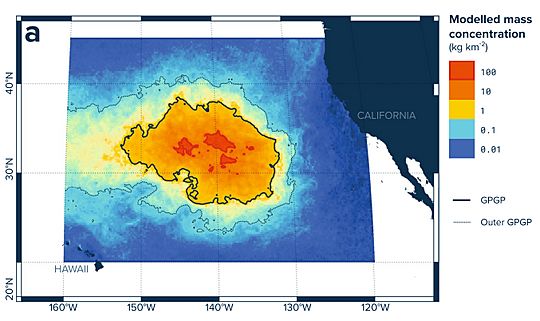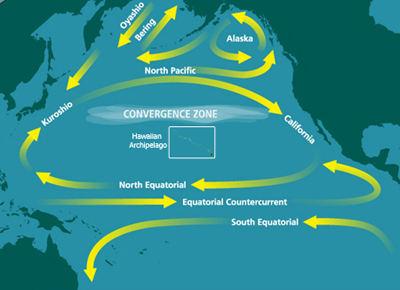Great Pacific garbage patch facts for kids
The Great Pacific Garbage Patch is a huge area in the central Pacific Ocean where lots of marine debris (trash in the ocean) gathers. It's often called the Pacific Trash Vortex. This patch is not a solid island of garbage. Instead, it's a swirling area of tiny plastic pieces and other floating trash.
This trash comes from countries all around the Pacific Ocean. This includes places in Asia, North America, and South America. Most of the garbage is made of very small pieces of plastic, often smaller than a fingernail. These tiny pieces are called microplastics. They float just below the surface of the water. This is why you can't see the patch from satellites or even from a boat.
Scientists have estimated that the patch covers about 1.6 million square kilometers. That's about twice the size of Texas! Most of the plastic in the patch (about 92%) is made up of larger items. These items haven't broken down into microplastics yet. Some of the plastic is over 50 years old. It includes things like plastic lighters, toothbrushes, water bottles, and plastic bags.
The amount of trash in the patch is growing quickly. It is believed to have increased ten times every ten years since 1945. For every pound of tiny ocean creatures called plankton, there are about six pounds of plastic. There's also a similar patch in the Atlantic Ocean called the North Atlantic garbage patch. This growing problem harms ocean animals and their homes.
Contents
How the Patch Formed
The Great Pacific Garbage Patch formed slowly over time. It happened because of ocean currents that gather pollution. The patch is in a calm area of the North Pacific Ocean. This area is surrounded by the North Pacific Gyre. A gyre is a large system of swirling ocean currents.
The gyre's spinning motion pulls in waste from all over the North Pacific. This includes trash from the coasts of North America and Japan. Once the trash gets caught in these currents, the wind and currents slowly move it towards the center. There, it gets trapped.
Most of the plastic trash in the ocean comes from land. About 80% of it washes into the ocean from coasts. The other 20% comes from boats and other ocean activities. A study in 2018 found that fishing nets make up almost half of the Great Pacific Garbage Patch's weight. This is due to ocean currents and more fishing in the Pacific.
Where the Plastic Comes From
In 2015, a study looked at where the garbage comes from. It found that most of the plastic floats eastward from six main countries in Asia. These countries are China, Indonesia, the Philippines, Vietnam, Sri Lanka, and Thailand. In 2010, China was responsible for about 30% of the world's ocean plastic pollution. By 2017, China, Indonesia, the Philippines, Thailand, and Vietnam together dumped more plastic into the sea than all other countries combined.
Groups like the Coastal Conservancy and Ocean Conservancy are working to slow down this flow of trash. They want to stop land-based garbage from reaching the ocean.
Animals and the Plastic Patch
Scientists have found that the plastic in the patch is home to many animals. In a 2021 study, researchers found over 40 different animal species living on 90% of the plastic they looked at. This includes jellyfish and sponges. These animals are usually found near coasts. But they are now living and reproducing in the open ocean on the plastic.
Some scientists worry that this mix of coastal and open-ocean species could create new, unnatural communities. Coastal creatures might compete with or even eat open-ocean species. This could change the ocean's natural balance.
How Big is the Patch?
It's hard to say exactly how big the Great Pacific Garbage Patch is. This is because it's not a solid island of trash. Most of the trash is tiny plastic pieces floating just below the surface. This makes it hard to see from planes or satellites.
Scientists estimate the patch is about 1.6 million square kilometers (about twice the size of Texas). But these are just estimates. It's hard to measure because the trash is spread out. Also, there's no clear line between "normal" ocean water and areas with "elevated" levels of pollution.
In 2009, a research trip found plastic debris in every sample taken along a 1,700-mile path through the patch. They found that while there are some large pieces, most of the patch is made of smaller, confetti-like pieces. These pieces become more concentrated towards the center of the gyre.
A study in 2018 used 30 vessels and an aircraft to survey the patch. They found that the patch covers 1.6 million square kilometers. They estimated there are 80,000 metric tons of plastic in the patch. This includes 1.8 trillion plastic pieces. About 92% of the weight comes from objects larger than 0.5 centimeters.
The National Ocean Service says that the term "Great Pacific Garbage Patch" can be misleading. It's not a giant island of trash that you can see from above. Instead, it's a widely spread area of tiny plastic pieces.
Efforts to Clean Up the Ocean
Many groups are working to clean up the Great Pacific Garbage Patch.
Ocean Voyages Institute's Project Kaisei
In 2009, the Ocean Voyages Institute removed over 5 metric tons of plastic. They were testing different cleanup tools. In 2019, they set a record by removing over 40 metric tons of plastic in 25 days. In 2020, they broke their own record twice. They removed 103 metric tons in one trip and 67 metric tons in another. In 2022, they removed 148 metric tons of plastic, including fishing nets and other debris.
The Ocean Cleanup
On September 9, 2018, The Ocean Cleanup project launched its first collection system. This system, called "System 001," was towed from San Francisco to a test site. After four months, the team learned a lot. This helped them design an improved system.
In 2021, The Ocean Cleanup collected over 63,182 pounds of plastic using their "System 002." In July 2022, they announced they had removed the first 100,000 kilograms of plastic from the patch. They are now moving to "System 03," which they say will be ten times more effective. They hope to clean up the entire patch within ten years.
See also
 In Spanish: Gran mancha de basura en el Pacífico para niños
In Spanish: Gran mancha de basura en el Pacífico para niños




